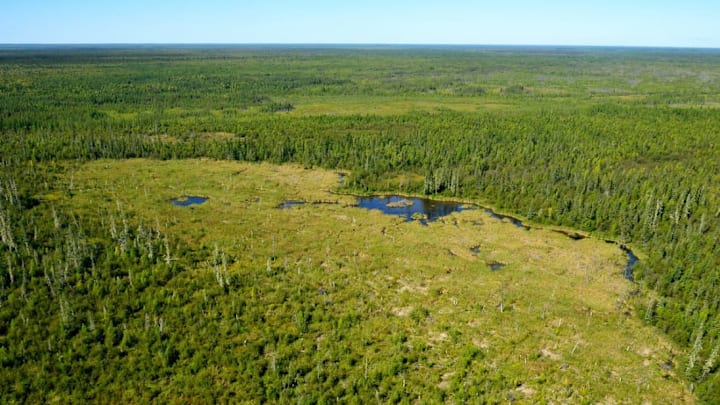In 2007, an ecologist named Jean Thie was scanning the Alberta wilderness with Google Earth in an effort to study permafrost thaw in the Canadian wild. But then something unusual appeared on his screen: A beaver dam so huge, it was more than twice the length of the Hoover Dam.
Located in Wood Buffalo National Park in Alberta, Canada, the world’s largest beaver dam is at least 2790 feet long. It likely contains thousands of trees and appears to have required the handiwork of at least two beaver families. It’s believed the beavers began the construction project up to three decades ago.
While it’s an impressive feat of animal engineering, the dam is not very scenic. “The hodgepodge of mud, branches, stones, and twigs is cloaked in a layer of grass, meaning it’s been there for a while,” Atlas Obscura reports. “The dam stretches across a remote wetland area, which provides the creatures with both plenty of fresh water and bountiful building materials.”
In fact, the dam is located in such an inhospitable area of Canadian swampland that it isn’t known to have been visited by humans until 2014, when Rob Mark, a member of the Explorers Club in New York City, made the trek. He began his journey in Fort Chipewyan, more than 120 miles away, and it took him five hours to cover the final mile (the ground was that boggy). “It was the only hard ground around for miles so I was happy to stand on it,” he said about reaching the dam.
Beavers build dams for a slew of reasons—take food storage. The critters will hide caches of food at the bottom of ponds and will build dams to increase the water’s depth, ensuring their stockpile of goodies won’t freeze over. Dams also function as a security system. “They create a habitat with lots of water like a moat around their lodges so they can swim and [dive] and keep one step ahead of predators such as coyotes and bears,” biologist Sharon Brown told The Telegraph.
This isn’t the only record-breaking beaver home in Canada, either. Thie also discovered that Pakwaw Lake, Saskatchewan, has what is likely the highest density of beaver dams in that country, and possibly the world—more than 20 dams and lodges per square kilometer (or about 247 acres).
Read More Amazing Animal Stories:
A version of this story was published in 2018; it has been updated for 2025.
